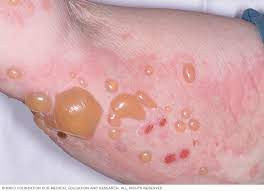Definition
Multiple sclerosis is a condition that impacts the central nervous system (the brain and spinal cord). It is characterized by the immune system attacking the myelin sheath of nerve cells. This condition affects approximately 2.5 million people worldwide. It occurs in episodes that are spaced several months or years apart, and it affects different parts of the nerves.
Causes
Multiple sclerosis is marked by nerve damage in the central nervous system. This nerve damage begins with inflammation and damage to the blood-brain barrier (BBB), a structure that separates blood vessels and the brain. The damage to the BBB is further exacerbated by the destruction of the myelin sheath. The myelin sheath is a fatty membrane that covers nerves and functions to speed up electrical conduction in nerves.
Inflammation is one form of the immune system's response to foreign substances, infection, cell damage, and other potentially harmful factors. However, in multiple sclerosis, the immune system attacks the myelin sheath. This slows or even blocks the electrical conduction in the nerves.
The cause of the immune system attacking the myelin sheath in multiple sclerosis is not known but is related to the interaction between genetic factors, viral infections, environmental factors, and vitamin D levels in the body.
Risk factor
Multiple sclerosis is more common in women than men, with a ratio of 3:1. The first episode of multiple sclerosis generally begins between the ages of 20-40 years. Genetic factors can also increase the risk of multiple sclerosis, especially if there is a father, mother, or sibling with multiple sclerosis. Additionally, viral infections associated with this condition include the Epstein-Barr virus (EBV), which activates immune cells that can attack the myelin sheath.
External factors, such as the environment, also influence the occurrence of multiple sclerosis. This condition is less common in tropical areas. Furthermore, vitamin D levels in the body are greatly influenced by sun exposure. The higher the sun exposure, the higher the vitamin D levels in the body, as seen in tropical areas. However, in certain regions like Norway, the population's diet is high in vitamin D, so despite low sun exposure, the incidence of multiple sclerosis is also lower. Vitamin D functions in regulating the immune system response by reducing the production of substances that trigger inflammation and increasing the production of substances that prevent inflammation.
Symptoms
The signs and symptoms of multiple sclerosis vary greatly depending on the person and the part of the nerve affected. This condition can affect body movement, causing limb weakness, a sensation of electric shock when bending the head, tremors (uncontrolled shaking), movement coordination disorders (performing multiple movements simultaneously), or unsteady walking. Additionally, there are vision complaints such as loss of vision in one eye, pain during eye movement, double vision, or blurred vision. Other symptoms can include slurred speech, fatigue, dizziness, tingling or pain in various body parts, and disturbances in sexual, digestive, and urinary functions such as diarrhea, constipation, bed-wetting, or difficulty urinating. Mood disturbances like depression or anxiety can also be symptoms of multiple sclerosis. Cognitive or higher functions like speech, concentration, memory, planning, problem-solving, and abstract thinking can also be affected.
Diagnosis
To diagnose multiple sclerosis, doctors may ask about your daily symptoms and your and your family's medical history. A physical examination may also be conducted to assess the reflexes of your nerves and your ability to coordinate movements. Additionally, eye and vision examinations are conducted to check for vision problems due to multiple sclerosis. The doctor may also ask you to walk to detect any abnormalities in your gait.
Other examinations that can be performed include imaging and laboratory tests. The imaging usually chosen for multiple sclerosis is magnetic resonance imaging (MRI) to see the location of brain and spinal cord tissue damage. Laboratory tests such as a lumbar puncture can also be performed to look for immune cells or signs of infection. A lumbar puncture is done by taking cerebrospinal fluid (the fluid that flows around the brain and spinal cord).
Management
Treatment for multiple sclerosis depends on the disease phase. If an acute attack occurs, the first priority is to stabilize conditions that may be life-threatening for the patient. An acute multiple sclerosis attack can be triggered by various factors, so these triggers need to be addressed as soon as possible. If the trigger is an infection, high doses of antibiotics will be given. If the infection is accompanied by a fever, administering fever-reducing medication like paracetamol can help lower the fever and improve nerve electrical conduction. Nerve electrical conduction is greatly influenced by body temperature if there is no myelin sheath protecting the nerves. Meanwhile, to reduce inflammation in multiple sclerosis, anti-inflammatory drugs like steroids or plasma exchange (plasmapheresis) can be used.
Next, to prevent multiple sclerosis episodes from recurring, medications to regulate the immune system can be given. Additionally, because multiple sclerosis is often accompanied by pain, pain relievers can also be administered. Other medications can be provided to alleviate symptoms such as muscle stiffness, depression, urinary or bowel problems, sexual problems, tremors, and inflammation of the optic nerves. Besides medications, physical therapy like muscle strengthening or occupational therapy such as planning daily activities can be done to maintain nerve function. Surgery may also be considered in managing multiple sclerosis symptoms.
Multiple sclerosis patients often complain about heat intolerance, so the following steps can be taken:
- Do outdoor work in the morning or evening to avoid the midday heat.
- Spread activities throughout the day to prevent the body from overheating due to excessive activity.
- Use air conditioning at home and in the car, and wear cooling and light-colored clothing. Also, wear a wide-brimmed hat when engaging in outdoor activities.
- Avoid saunas, hot tubs, or even hot baths.
- Avoid high-humidity environments; indoors, use a room dryer.
- If a fever occurs, immediately take fever-reducing medication like paracetamol.
Complications
Complications of multiple sclerosis vary greatly, depending on the part of the central nervous system affected. Multiple sclerosis can cause muscle stiffness, muscle paralysis, especially in the legs, urinary problems like urinary tract infections, bowel problems like constipation, and sexual problems like erectile dysfunction, mental changes becoming forgetful or having mood swings, depression, and epilepsy.
Prevention
Multiple sclerosis can be prevented by adequate vitamin D intake. Consuming and supplementing with vitamin D is good for bones and overall health, as well as reducing inflammation that can trigger multiple sclerosis.
When to see a doctor?
See a doctor immediately if you or someone around you experiences symptoms of multiple sclerosis such as limb weakness, tingling sensations in various body areas, vision loss in one eye, difficulty urinating or defecating, becoming forgetful, or experiencing severe mood changes like depression. Long-term multiple sclerosis can cause disability, so it needs to be addressed early.
Looking for more information about other diseases? Click here!
- dr Hanifa Rahma
Luzzio, C. Multiple Sclerosis: Practice Essentials, Background, Pathophysiology (2020). Retrieved 9 December 2021, from https://emedicine.medscape.com/article/1146199-overview
Multiple sclerosis - Symptoms and causes (2021). Retrieved 9 December 2021, from https://www.mayoclinic.org/diseases-conditions/multiple-sclerosis/symptoms-causes/syc-20350269
Tafti, D., Ehsan, M., & Xixis, K. Multiple Sclerosis (2021). Retrieved 9 December 2021, from https://www.ncbi.nlm.nih.gov/books/NBK499849/



/64c77c8a156f0.jpg)








